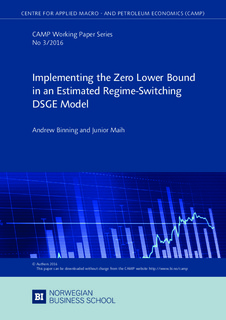| dc.contributor.author | Binning, Andrew | |
| dc.contributor.author | Maih, Junior | |
| dc.date.accessioned | 2017-02-02T11:35:55Z | |
| dc.date.available | 2017-02-02T11:35:55Z | |
| dc.date.issued | 2016 | |
| dc.identifier.issn | 1892-2198 | |
| dc.identifier.uri | http://hdl.handle.net/11250/2429262 | |
| dc.description.abstract | The Zero Lower Bound (ZLB) on policy rates is one of the key monetary policy issues du jour. In this paper we investigate the problem of modelling and estimating the ZLB in a simple New Keynesian model with regime switches. The key features of the model include switches in the time preference shock, productivity growth rate and the steady state rate of in ation leading to two steady states: a normal steady state and a ZLB steady state. The model is tted to US data using Bayesian methods and is found to match the US experience over the great moderation and the ZLB periods very well. The key features of the model allow us to test competing theories about the determinants of the ZLB steady state. Our results suggest that the ZLB steady state is driven by precautionary savings behavior. It is also found that expectations over di erent regimes crucially matter for the dynamics of the system. | nb_NO |
| dc.language.iso | eng | nb_NO |
| dc.publisher | BI Norwegian Business School | nb_NO |
| dc.relation.ispartofseries | CAMP Working Paper Series;3/2016 | |
| dc.subject | Zero Lower Bound, Regime-switching, DSGE, Bayesian Estimation | nb_NO |
| dc.title | Implementing the Zero Lower Bound in an Estimated Regime-Switching DSGE Model | nb_NO |
| dc.type | Working paper | nb_NO |
| dc.source.pagenumber | 45 | nb_NO |
